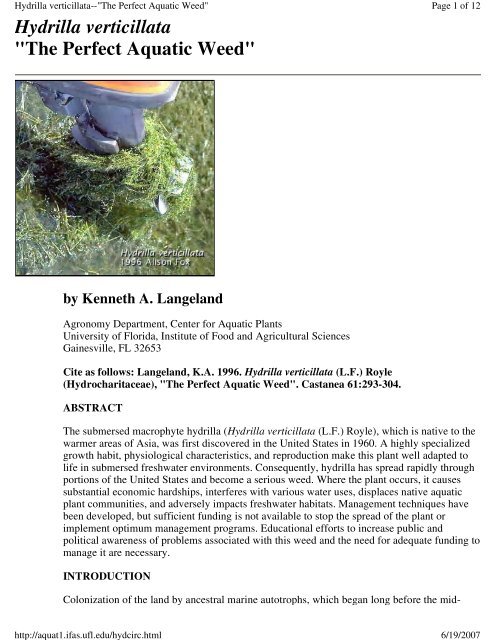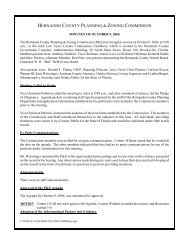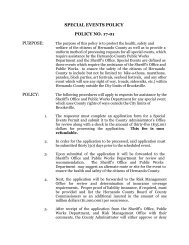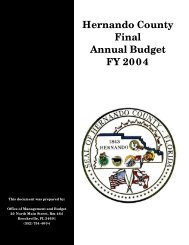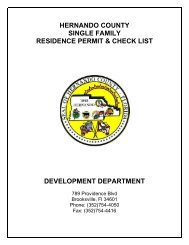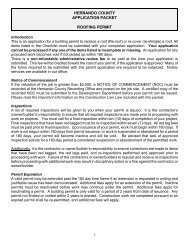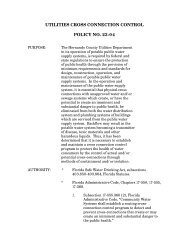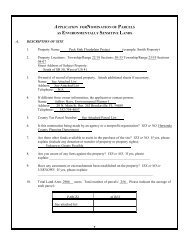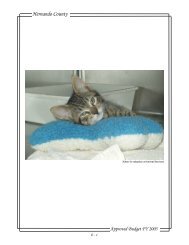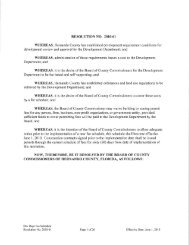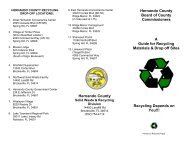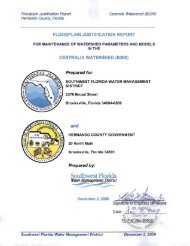Hydrilla verticillata "The Perfect Aquatic Weed"
Hydrilla verticillata "The Perfect Aquatic Weed"
Hydrilla verticillata "The Perfect Aquatic Weed"
You also want an ePaper? Increase the reach of your titles
YUMPU automatically turns print PDFs into web optimized ePapers that Google loves.
http://aquat1.ifas.ufl.edu/hydcirc.html<br />
6/19/2007<br />
<strong>Hydrilla</strong> <strong>verticillata</strong>--"<strong>The</strong> <strong>Perfect</strong> <strong>Aquatic</strong> Weed"<br />
<strong>Hydrilla</strong> <strong>verticillata</strong><br />
"<strong>The</strong> <strong>Perfect</strong> <strong>Aquatic</strong> Weed"<br />
Page 1 of 12<br />
by Kenneth A. Langeland<br />
Agronomy Department, Center for <strong>Aquatic</strong> Plants<br />
University of Florida, Institute of Food and Agricultural Sciences<br />
Gainesville, FL 32653<br />
Cite as follows: Langeland, K.A. 1996. <strong>Hydrilla</strong> <strong>verticillata</strong> (L.F.) Royle<br />
(Hydrocharitaceae), "<strong>The</strong> <strong>Perfect</strong> <strong>Aquatic</strong> Weed". Castanea 61:293-304.<br />
ABSTRACT<br />
<strong>The</strong> submersed macrophyte hydrilla (<strong>Hydrilla</strong> <strong>verticillata</strong> (L.F.) Royle), which is native to the<br />
warmer areas of Asia, was first discovered in the United States in 1960. A highly specialized<br />
growth habit, physiological characteristics, and reproduction make this plant well adapted to<br />
life in submersed freshwater environments. Consequently, hydrilla has spread rapidly through<br />
portions of the United States and become a serious weed. Where the plant occurs, it causes<br />
substantial economic hardships, interferes with various water uses, displaces native aquatic<br />
plant communities, and adversely impacts freshwater habitats. Management techniques have<br />
been developed, but sufficient funding is not available to stop the spread of the plant or<br />
implement optimum management programs. Educational efforts to increase public and<br />
political awareness of problems associated with this weed and the need for adequate funding to<br />
manage it are necessary.<br />
INTRODUCTION<br />
Colonization of the land by ancestral marine autotrophs, which began long before the mid-
http://aquat1.ifas.ufl.edu/hydcirc.html<br />
6/19/2007<br />
<strong>Hydrilla</strong> <strong>verticillata</strong>--"<strong>The</strong> <strong>Perfect</strong> <strong>Aquatic</strong> Weed"<br />
Paleozoic, gave rise to evolution of vascular plants (Sculthorpe 1967). Ecological adaptability<br />
has allowed this group to evolve species that have colonized diverse terrestrial habitats from<br />
desert to tundra. A small group of plants, 1 per cent by most liberal estimates, returned to life<br />
in aquatic and marine environments (Sculthorpe 1967). <strong>The</strong>se fresh water and marine vascular<br />
plants, as a group, are particularly fascinating because of numerous adaptations they have<br />
evolved as they returned to the submersed environment. One of the most studied aquatic<br />
vascular plants is hydrilla (<strong>Hydrilla</strong> <strong>verticillata</strong> (L.F.) Royle (Hydrocharitaceae)). <strong>Hydrilla</strong><br />
could easily be called the perfect aquatic plant because of the extensive adaptive attributes it<br />
possesses to survive in the aquatic habitat. <strong>The</strong>se characteristics allow <strong>Hydrilla</strong> to be an<br />
aggressive and competitive colonizer of aquatic habitats. <strong>Hydrilla</strong> has become a serious pest in<br />
North American waters. This paper will discuss hydrilla as "the perfect aquatic weed" in North<br />
America.<br />
IDENTIFICATION<br />
Here are pictures of hydrilla...<br />
Page 2 of 12<br />
<strong>Hydrilla</strong> is highly polymorphic, its appearance can vary considerably depending upon the<br />
conditions under which it is growing (Verkleij et al. 1983; Pieterse et al. 1985). It grows<br />
submersed in water and generally is rooted to the bottom, although sometimes fragments will<br />
break loose and survive in a free-floating state. Erect stems can be quite long when the plant<br />
grows in deep water. Branching is usually sparse until the plant grows to near the water<br />
surface, then branching becomes profuse. Many horizontal above-ground stems (stolons) and<br />
underground stems (rhizomes) are also produced. Leaves are 2-4 mm wide, 6-20 mm long, and<br />
occur in whorls of 3-8. <strong>The</strong> leaves have 11-39 sharp teeth per cm along the margins and often<br />
have either spines or glands on the underside of the midrib. <strong>The</strong> midrib is also often red.<br />
Adventitious roots are usually glossy white unless growing in highly organic sediments in<br />
which case they take on the reddish brown color of the sediment, or they can have a green cast<br />
caused by the presence of chlorophyll when exposed to light.<br />
<strong>Hydrilla</strong> can be either monoecious or dioecious with both male and female flowers singly<br />
froma spathe (Cook and L”nd 1982, Pieterse 1981). Female flowers consist of three whitish<br />
sepals and three translucent petals, are 10-50 mm long, 4-8 mm wide, attached at leaf axils, are<br />
clustered toward the tips of the stems, and float on the water surface. <strong>The</strong> stem tips from which<br />
female flowers arise are often very compact and have very short leaves. Female flowers are<br />
resistant to wetting and when returned to the water surface after submergence will immediately<br />
re-float. A submerged female flower has been described as an inverted bell filled with a large<br />
bubble. Male flowers have three whitish red or brown sepals that are up to 3 mm long and<br />
2mm wide. <strong>The</strong>y have three whitish or reddish linear petals that are about 2mm long and they<br />
have three stamens which are formed in leaf axils. Male flowers are released and float to the<br />
surface as they approach maturity. Thousands of these free floating male flowers are<br />
sometimes observed in windrows on ponds (Langeland and Schiller, 1983). Both male and<br />
female flowers are produced singly from the spathe.<br />
<strong>Hydrilla</strong> produces hybernacula, turions in leaf axils and tubers (subterranean turions)<br />
terminally on rhizomes. Turions are very compact dormant buds that are produced in leaf axils<br />
and fall from the plant when they mature. <strong>The</strong>se structures are 5-8 mm long, dark green, and<br />
appear to be spiny. Tubers are formed terminally on rhizomes or stolons and can be found 30<br />
cm deep in the sediment. <strong>The</strong>y are 5-10 mm long and are off-white to yellow unless they take
http://aquat1.ifas.ufl.edu/hydcirc.html<br />
6/19/2007<br />
<strong>Hydrilla</strong> <strong>verticillata</strong>--"<strong>The</strong> <strong>Perfect</strong> <strong>Aquatic</strong> Weed"<br />
on darker colors from organic sediments.<br />
Page 3 of 12<br />
DISTRIBUTION<br />
<strong>Hydrilla</strong> is probably native to the warmer regions of Asia (Cook and L”nd 1982). It is a<br />
cosmopolitan species that occurs in Europe, Asia, Australia, New Zealand, the Pacific Islands,<br />
Africa, Europe, South America, and North America. Although hydrilla occurs in temperate<br />
areas, it tends to be more widespread in tropical areas of the world.<br />
<strong>Hydrilla</strong> was discovered in the United States in 1960 at two Florida locations, a canal near<br />
Miami and in Crystal River (Blackburn et al. 1969). It spread throughout the state very<br />
rapidly. By the early 1970s it was established in major water bodies of all drainage basins in<br />
the state. In 1988, the Florida Department of Natural Resources estimated over 20,000 ha of<br />
water in Florida contained hydrilla (Schardt and Nall 1988). <strong>Hydrilla</strong> continues to spread in<br />
Florida and in 1995 covers 40,000 ha of water in 43% of public lakes. <strong>Hydrilla</strong> is now found in<br />
all Gulf Coast states, Atlantic Coast States as far north as Maryland and Delaware, and in the<br />
western states, California, Washington, and Arizona.<br />
It is evident that there have been at least two hydrilla introductions into the United States<br />
because at least two different forms occur. Florida populations are dioecious female, as are all<br />
wild populations thus far observed as far north as Lake Marion in South Carolina. Most<br />
populations north of Lake Marion are monoecious. <strong>The</strong> exceptions are a dioecious population<br />
in Wilmington, North Carolina and both dioecious and monoecious plants in Lake Gaston,<br />
which borders North Carolina and Virginia (Ryan et al. 1995).<br />
A major question that remains is how far north in the United States hydrilla will spread and<br />
whether it will be a problem in the northern states as it is in the southern states. <strong>The</strong><br />
northernmost monoecious hydrilla population occurs at approximately 40o north latitude in the<br />
United States. In Poland and the Soviet Union, hydrilla occurs near 50o north latitude. <strong>The</strong>se<br />
latitudes are similar to US and Canadian border and suggest the northern limit for hydrilla<br />
colonization in the northern hemisphere. However, hydrilla does not seem to spread readily<br />
from existing populations in Northeastern Europe (Cook and L”nd 1982). Still, how far north<br />
in the United States hydrilla will thrive and be a weed problem remains a question.<br />
Research suggests that the monoecious strain is better adapted to the temperate climate<br />
because it can form tubers more quickly during short photoperiods (Spencer and Anderson<br />
1986, Van 1989) and also during long photoperiod (Van 1989). This may explain the<br />
distribution of the monoecious and dioecious populations along the Atlantic coast, or the<br />
distribution could be coincidental.<br />
BIOLOGY AND PHYSIOLOGY<br />
<strong>Hydrilla</strong> can establish and then displace native aquatic plants such as pondweeds<br />
(Potamogeton sp.) and eelgrass (Vallisneria americana Michaux). While all aquatic plants<br />
have developed adaptations for life in the aquatic environment, hydrilla seems to be a couple<br />
of steps ahead of other submersed plants. Research has identified many of the characteristics<br />
that enable hydrilla to exist and compete so effectively. Some of these characteristics are very<br />
simple and effective while others are complex and of scientific interest.
http://aquat1.ifas.ufl.edu/hydcirc.html<br />
6/19/2007<br />
<strong>Hydrilla</strong> <strong>verticillata</strong>--"<strong>The</strong> <strong>Perfect</strong> <strong>Aquatic</strong> Weed"<br />
Page 4 of 12<br />
<strong>The</strong> growth habit of hydrilla enables it to compete effectively for sunlight. It can elongate very<br />
rapidly, up to one inch per day, until it nears the water surface. Near the water surface it<br />
branches profusely and produces greater stem density than other submersed aquatic plants.<br />
One half of hydrilla standing crop occurs in the upper 0.5 m of water column (Haller and<br />
Sutton 1975). By producing this mat of vegetation on the water surface hydrilla is able to<br />
intercept sunlight to the exclusion of other submersed plants. <strong>Hydrilla</strong> makes efficient use of<br />
available nutrients. <strong>Hydrilla</strong> tissue is composed of approximately 90% water (Van et al. 1976).<br />
<strong>The</strong>refore, the plants can produce a great deal of fresh plant material from a limited supply of<br />
the essential plant nutrients carbon, nitrogen and phosphorus.<br />
<strong>Hydrilla</strong> is able to grow under a wide range of water chemistry conditions. It is commonly<br />
found in oligotrophic (low nutrients) to eutrophic (high nutrients) lakes (Cook and L”nd<br />
1982). It can grow in water up to about 7% the salinity of seawater (Haller et al. 1974) or<br />
higher (Steward and Van 1987); and it tolerates a wide range of pH, but tends to grow better at<br />
pH 7 (Steward 1991).<br />
<strong>Hydrilla</strong> is adapted to use low light levels for photosynthesis (Van et al. 1976, Bowes et al.<br />
1977). This means that hydrilla can begin to photosynthesize earlier in the morning and thus<br />
successfully compete with other aquatic plants for limited dissolved carbon in the water . <strong>The</strong><br />
low light requirement (1% of full sunlight or less) also allows hydrilla to colonize in deeper<br />
water than other aquatic plants. <strong>Hydrilla</strong> has been found growing at a depth of 15 m in Crystal<br />
River and commonly occurs in water 3 m deep in Florida lakes.<br />
Submersed plants are subjected to constraints on photosynthesis in comparison to terrestrial<br />
plants. Owing to the 104x slower diffusion rate of carbon dioxide in water than air, efficient<br />
use of bicarbonate ion as a dissolved inorganic carbon source is an important competative<br />
characteristic for existence in the aquatic environment. <strong>Hydrilla</strong> can use free carbon dioxide<br />
from surrounding water when it is available and can switch to bicarbonate utilization when<br />
conditions favors its use i.e., high pH and high carbonate concentration (Salvucci and Bowes<br />
1983). <strong>The</strong>se conditions occur in highly productive waters during warm water and high<br />
photosynthesis conditions. Under these conditions, hydrilla can also switch to C4-like carbon<br />
metabolism, characterized by low photorespiration, and inorganic carbon fixed into malate and<br />
aspartate (Holaday and Bowes 1980).<br />
<strong>Hydrilla</strong> is very efficient at reproducing itself and maintaining itself during adverse conditions.<br />
It can reproduce itself in four different ways. <strong>The</strong>se are: fragmentation, tubers, turions, and<br />
seed.<br />
Almost 50% of hydrilla fragments that have a single whorl of leaves can sprout a new plant<br />
that a new population can grow from, and greater than 50% of fragments with only three<br />
whorls of leaves can sprout (Langeland and Sutton, 1980). This means that small amounts of<br />
hydrilla on boat trailers, bait buckets, draglines, and from aquariums can spread the plant from<br />
place to place.<br />
Turions are formed terminally on rhizomes (commonly called tubers or subterranean turions)<br />
and in leaf axils (commonly called turions or axillary turions). One single subterranean turion<br />
has been shown to produce over 6000 new turions per m2 (Sutton et al. 1992), and 2,803<br />
axillary turions can potentially be produced per m2 (Thullen 1990). Subterranean turions can<br />
remain viable for several days out of water (Basiouny et al.1978), and for over four years in
http://aquat1.ifas.ufl.edu/hydcirc.html<br />
6/19/2007<br />
<strong>Hydrilla</strong> <strong>verticillata</strong>--"<strong>The</strong> <strong>Perfect</strong> <strong>Aquatic</strong> Weed"<br />
undisturbed sediment (Van and Steward, 1990). <strong>The</strong>y also survive ingestion and regurgitation<br />
by waterfowl (Joyce et al. 1980), and herbicide applications (Haller et al. 1990).<br />
Seed production is probably of minor importance to hydrilla reproduction compared to its<br />
successful vegetative reproduction. Although seed production and viability is low compared to<br />
many other weeds (Langeland and Smith 1984), the importance of seed production has not<br />
been well researched and is not adequately understood. Seeds of many plants can be ingested<br />
by birds, carried for long distances, and passed through the gut in a viable condition. If this<br />
proves to be true for hydrilla seed, it may prove to be an important means of natural, long<br />
distance dispersal.<br />
IMPORTANCE<br />
Page 5 of 12<br />
<strong>Hydrilla</strong> causes major detrimental impacts on water use. In drainage canals it greatly reduces<br />
flow, which can result in flooding and damage to canal banks and structures. In irrigation<br />
canals it impedes flow and clogs intakes of pumps used for conveying irrigation water. In<br />
utility cooling reservoirs it disrupts flow patterns that are necessary for adequate cooling of<br />
water. <strong>Hydrilla</strong> can severely interfere with navigation of both recreational and commercial<br />
craft. In addition to interfering with boating by fisherman and waterskiers in recreational<br />
waters, hydrilla interferes with swimming, displaces native vegetation communities, and can<br />
adversely impact sportfish populations. <strong>The</strong> economic impacts of these water uses to real<br />
estate values, tourism, and user groups can be staggering. For example, an economic study on<br />
Orange Lake in North Central Florida indicated that the economic activity attributed to the<br />
lake was almost $11.0 million and during years that hydrilla completely covers the lake these<br />
benefits can be virtually lost (Milon et al. 1986). Cost of hydrilla management is also<br />
extremely high, especially when funding is insufficient for adequate management. An<br />
estimated $10.0 million is necessary to manage hydrilla in Florida public waters in 1994-95<br />
and $14.5 million will be necessary in 1995-96, as hydrilla continues to expand (Jeff Schardt,<br />
Florida Department of Environmental Protection, personal communication). Some sport<br />
fishermen consider hydrilla to benefit largemouth bass habitat (Tucker 1987). While the<br />
opinion that hydrilla is beneficial for sportfish production is supported by certain research<br />
(Estes et al. 1990; Porak et al. 1990), other research suggests that largemouth bass are<br />
adversely affected when hydrilla coverage exceeds 30% (Colle and Shireman 1980). Canfield<br />
and Hoyer (1992) found no relation between standing crop of harvestable largemouth bass and<br />
percent area covered with aquatic macrophytes in 60 Florida lakes (many dominated by<br />
hydrilla). When fish biomass was adjusted for lake trophic state (chlorophyll a), maximum<br />
biomass tended to occur in lakes when 20% to 40% of the lake volume was occupied by<br />
aquatic macrophytes. <strong>Hydrilla</strong> is eaten by waterfowl, and maintaining hydrilla populations is<br />
sometimes advocated by waterfowl scientists because it increases the feeding habitat for ducks<br />
(Johnson and Montalbano 1984, Esler 1989).<br />
Highly transparent water is often considered desirable by the public and large populations of<br />
submersed aquatic macrophytes, such as hydrilla, will tend to increase water clarity (Canfield<br />
et al. 1984). <strong>The</strong> exact reasons for this increase in water clarity are not completely understood<br />
but it probably results from a combination of factors which include lowering sediment resuspension<br />
and reduction of phytoplankton populations by compartmentalizing nutrients.<br />
Regardless, large amounts of aquatic macrophytes are necessary to cause substantial increases<br />
in water clarity (Canfield et al. 1984; Canfield and Hoyer 1992).
http://aquat1.ifas.ufl.edu/hydcirc.html<br />
6/19/2007<br />
<strong>Hydrilla</strong> <strong>verticillata</strong>--"<strong>The</strong> <strong>Perfect</strong> <strong>Aquatic</strong> Weed"<br />
<strong>The</strong> endeavor to benefit sportfish or waterfowl habitat or produce clear water has resulted in<br />
deliberate dispersal of hydrilla by individuals unwary of the severe detrimental impacts that<br />
can be caused by the plant. Detrimental impacts caused by hydrilla far outweigh beneficial<br />
impacts and it is usually more difficult to manage than native plant populations, which it<br />
displaces.<br />
MANAGEMENT<br />
Page 6 of 12<br />
<strong>Hydrilla</strong> is managed differently in different types of waters, which depends on water uses.<br />
<strong>The</strong>refore different methods or combination of methods are used depending on the desired end<br />
result. In water conveyance systems, the end result may be no vegetation, whereas in<br />
recreational waters the goal is usually to improve the environment by selectively controlling<br />
hydrilla amongst native vegetation. Management methods include herbicides, grass carp<br />
(Ctenopharyngodon idella Val.), and mechanical removal. Insects have been released for<br />
classical biological control agents and others are under study.<br />
<strong>The</strong> herbicide active ingredients, copper, diquat, endothall, and fluridone can be used to<br />
selectively control hydrilla to some extent, depending on the associated plant community.<br />
Copper, diquat and endothall are fast acting contact herbicides that have relatively broad<br />
spectrums on submersed aquatic plants. <strong>The</strong>y are used to selectively control hydrilla by<br />
injection of liquid herbicides, from trailing hoses, under floating leafed vegetation such as<br />
spadderdock (Nuphar sp.) or around emergent vegetation such as bulrush (Scirpus sp.)<br />
(Langeland et al. 1991). Granular endothall can be used in the same manner. Fluridone is only<br />
effective for whole-pond applications or large scale (>2 ha.) applications in large water bodies<br />
and its selectivity is dependent on application rates, contact times, and timing of applications.<br />
For example, fluridone has been used to manage hydrilla in Lake Okeechobee with minimum<br />
to no long term impact on a native vegetation community consisting of southern naiad (Najas<br />
guadalupensis (Sprang.) Magnus), eelgrass, pondweed (Potamogeton illinoensis Morong), and<br />
American lotus (Nelumbo lutea Willd.) (Langeland et al. 1991).<br />
Grass carp is a herbivorous fish that is effective for controlling hydrilla (Van Dyke et al.<br />
1984). Possession of this fish is illegal in most states because of the potential environmental<br />
damage that could result if escaped fish establish a breeding population. Sterile, triploid grass<br />
carp (Malone 1984) are also effective (Cassani and Caton 1986) and are now available and<br />
legal by permit in some states in the U.S. In small ponds or lakes and canal systems, with<br />
adequate control structures, and where total removal of vegetation is acceptable, triploid grass<br />
carp stocking is highly recommended. <strong>The</strong>y have been used to selectively manage hydrilla in<br />
water detention ponds where emergent vegetation was desirable but this use is unpredictable<br />
(personal communications with contractors). Because they are non-specific herbivores, an<br />
adequate method of recapturing the fish has not been developed, and because stocking rates for<br />
partial control have not been established, grass carp are rarely used in large multi-purpose<br />
lakes where aquatic vegetation is desirable for sportfish and waterfowl habitat.<br />
Specialized machines are used for mechanically removing hydrilla. However, this is not a<br />
widespread practice because of the high cost involved, which is often over $1000 per acre and<br />
because of logistical constraints in large water bodies. Because of hydrilla's rapid growth rate,<br />
up to six harvests are required annually (McGehee 1979). Mechanical removal is mainly used<br />
for hydrilla management in proximity to domestic water supply intakes, in rapidly flowing<br />
water, and when immediate removal is necessary.
http://aquat1.ifas.ufl.edu/hydcirc.html<br />
6/19/2007<br />
<strong>Hydrilla</strong> <strong>verticillata</strong>--"<strong>The</strong> <strong>Perfect</strong> <strong>Aquatic</strong> Weed"<br />
Page 7 of 12<br />
A commonly asked question is if there is a use for harvested plant material that would help<br />
defray the high cost of harvesting. Research has been conducted to determine the feasibility of<br />
using harvested hydrilla for practical purposes, such as cattle feed (Easley and Shirley 1974,<br />
Bagnall et al. 1978). Considering the high cost of harvesting hydrilla and its low nutritive<br />
value and fiber content compared to its wet bulk very little return can be derived from the<br />
product.<br />
Some of the earliest research for classical biological control of hydrilla was with snails<br />
(Blackburn and Taylor 1968). Snails are very effective at consuming large amounts of hydrilla<br />
when they are present in high density in enclosed experimental areas. However under natural<br />
environmental conditions they are not effective. Likewise, plant pathogens have been isolated<br />
that are effective against hydrilla under experimental conditions (Charudattan and Lin, 1974;<br />
Charudattan and McKinney 1978), but not under natural conditions.<br />
Insects offer promise as biological suppressants for hydrilla, but as yet none has been shown to<br />
effectively fit into management programs. Here are pictures and more information about<br />
biocontrol insects for hydrilla.<br />
Extensive, worldwide surveys for natural hydrilla enemies were begun in 1981 in a<br />
cooperative study between the University of Florida-IFAS, United States Department of<br />
Agriculture, and U.S. Army Corps of Engineers. Over 40 species of insects have been found<br />
that feed on hydrilla. Several of these are presently being evaluated as potential hydrilla<br />
biosuppressants in the United States and other insects from Australia are under consideration<br />
(Center 1992). Bagous affinis Hustache is a weevil that was discovered in Pakistan and India.<br />
This is not a truly aquatic insect, but the adult lays its eggs on rotting wood and other organic<br />
matter and after hatching the larvae burrows through the sediment until it encounters a hydrilla<br />
tuber (Bennett and Buckingham 1991). <strong>The</strong> tuber is then destroyed as the insect feeds on it<br />
while it completes its life cycle. This insect will only be potentially useful in combination with<br />
lake drawdown or intermittently wet and dry shorelines. Another un-named Bagous sp. has<br />
been released in U. S. but has not become established. Hydrellia pakistanae Deonier is a leaf<br />
mining fly that is very promising as a hydrilla biosuppressant (Buckingham et al. 1989). H.<br />
pakistanae is established in Florida but it's impact on hydrilla is undetermined.<br />
An aquatic moth, Parapoynx diminutalis Snellen, was accidentally introduced into the United<br />
States (Del Fosse et al. 1976). <strong>The</strong> larvae of this moth can frequently be found feeding in large<br />
numbers on hydrilla, however extensive damage does not occur until late in the growing<br />
season after hydrilla is already at problem levels. Although the moth larvae sometimes<br />
defoliates large areas of hydrilla, the viable stems remain and the plant remains a problem.<br />
Predators, such as fish, also limit the density of P. diminutalis populations (Perkins 1978) and<br />
it does not appear to be an effective biosuppressant for hydrilla.<br />
Even manatees or sea cows (Trichechus manatus) have been considered for biological control<br />
of hydrilla. A study conducted by the U.S. Fish and Wildlife Service reported that over 1000<br />
manatees, 10 times the actual number of 116, would be needed to consume just the standing<br />
biomass of hydrilla in Kings Bay (Crystal River, Florida) (Etheridge et al. 1985). <strong>The</strong> manatee<br />
is not presently considered for use as a potential biological control for hydrilla because it's<br />
numbers are too few, it is not well suited for moving from place to place, and it is an<br />
endangered species.
http://aquat1.ifas.ufl.edu/hydcirc.html<br />
6/19/2007<br />
<strong>Hydrilla</strong> <strong>verticillata</strong>--"<strong>The</strong> <strong>Perfect</strong> <strong>Aquatic</strong> Weed"<br />
<strong>The</strong> use of drawdown for aquatic plant management is limited to those lakes or ponds that<br />
have sufficient water control structures and hydrologic characteristics to adequately control<br />
water level, and where drawdown will not interfere with other primary water uses such as<br />
domestic or irrigation supplies, navigation, or hydrologic power. Following hydrilla life cycle<br />
research it was suggested that drawdown may be used successfully for hydrilla management<br />
by timing drawdowns to prevent tuber formation in the fall and vegetative regrowth and<br />
sprouting of tubers in the spring (Haller et al., 1976). Large scale tests of this drawdown<br />
schedule for hydrilla control in Florida have demonstrated that hydrilla can be temporarily<br />
controlled, but tubers remained dormant and viable in organic hydrosoils. Also, other areas<br />
were quickly colonized by fragments from unaffected areas (Haller and Shireman 1983).<br />
Similarly, drawdown for hydrilla control in North Carolina and Virginia, where lake bottoms<br />
had a high clay content, was unsuccessful (Hodson et. al 1984, Langeland and Pesacreta<br />
1986).<br />
<strong>The</strong> old saying "an ounce of prevention is worth a pound of cure" is very applicable to hydrilla<br />
control. In states such as Florida where hydrilla is widespread, it is difficult to totally prevent<br />
movement of the plant between public lakes. However, an aggressive educational program can<br />
prevent many heartaches for private pond owners and may prevent the spread of hydrilla into<br />
new areas of the country. State and federal agencies can help by developing and implementing<br />
programs to educate the public about the problems that can arise from the introduction of nonnative<br />
aquatic plants, such as hydrilla, to lakes rivers and ponds. <strong>The</strong>se programs should be<br />
directed toward water resource user groups, such as fishing clubs and aquaculturists and also<br />
to aquarium hobbyists. Programs should include information on ways to identify these plants<br />
and to prevent their introduction, by careful checking and then removal of plant fragments<br />
from boats and trailers.<br />
SUMMARY<br />
<strong>Hydrilla</strong> was introduced into the United States about 35 years ago (ca. 1960). Because of<br />
unique biological and physiological characteristics and an aggressive growth habit, hydrilla<br />
has established itself in a wide range of aquatic habitats. Once established in a system it can<br />
alter the environment detrimentally by replacing native aquatic vegetation and affecting fish<br />
populations. Monetary losses occur when waterfront property values are reduced as a result of<br />
these environmental impacts or when interference with boating access reduces recreational use<br />
of the water body. In urban and agricultural situations hydrilla interferes with the movement of<br />
water for drainage or irrigation purposes and again, monetary or property losses can result.<br />
Through scientific research, innovative aquatic plant management programs, and educational<br />
programs we have dealt with many of the challenges presented by this weed. However,<br />
hydrilla management costs millions of dollars annually and many water resources are<br />
diminished because of hydrilla infestations that cannot be remedied. Many challenges remain<br />
and it is hoped that further advances in hydrilla management will be made in the years to<br />
come.<br />
LITERATURE CITED<br />
Bagnall, L. O., K. E. Dixon and J. F. Hentges, Jr. 1978. <strong>Hydrilla</strong> silage production,<br />
composition and acceptability. J. Aquat. Plant Manage. 16:27-31.<br />
Page 8 of 12
http://aquat1.ifas.ufl.edu/hydcirc.html<br />
6/19/2007<br />
<strong>Hydrilla</strong> <strong>verticillata</strong>--"<strong>The</strong> <strong>Perfect</strong> <strong>Aquatic</strong> Weed"<br />
Basiouny, F. M., W. T. Haller and L. A. Garrard. 1978. Survival of hydrilla (<strong>Hydrilla</strong><br />
<strong>verticillata</strong>) plants and propagules after removal from the aquatic habitat. Weed Sci. 26:502-<br />
504.<br />
Bennett, C. A. and G. R. Buckingham. 1991. Laboratory biologies of Bagous affinis and B.<br />
laevigatus (Coleoptera: Curculionidae) attacking tubers of <strong>Hydrilla</strong> <strong>verticillata</strong><br />
Hydocharitaceae). Ann. Entomol. Soc. Amer. 84(4):421-428.<br />
Blackburn, R. D. and T. M. Taylor. 1968. Snails for aquatic weed control. In Proc. Weed Sci.<br />
Soc. Am. p. 51.<br />
Blackburn, R. D., L. W. Weldon, R. R. Yeo and T. M. Taylor. 1969. Identification and<br />
distribution of certain similar-appearing submersed aquatic weeds in Florida. Hyacinth Contr.<br />
J. 8:17-23.<br />
Bowes, G. A. S. Holaday, T. K. Van and W. T. Haller. 1977. Photosynthetic and<br />
photorespiratory carbon metabolism in aquatic plants. In Proceedings 4th Int. Congress of<br />
Photosynthesis, Reading (UK) pp. 289-298.<br />
Buckingham, G. R., E. A. Okrah and M. C. Thomas. 1989. Laboratory host range tests with<br />
Hydrellia pakistanae (Diptera: Ephydridae), an agent for biological control of <strong>Hydrilla</strong><br />
<strong>verticillata</strong> (Hydrocharitaceae). Environ. Entomol. 18(1):164-171.<br />
Canfield, D. E., Jr., and M. V. Hoyer. 1992. <strong>Aquatic</strong> macrophytes and their relationships to<br />
Florida lakes. Final Report submitted to Bureau of <strong>Aquatic</strong> Plants, Florida Department of<br />
Natural Resources, Tallahassee, FL 32303. 599 pp. Canfield, D. E., Jr., J. V. Shireman, D. E.<br />
Colle, W. T. Haller, E. E. Watkins and M. J. Maceina. 1984. Prediction of chlorophyll a<br />
concentration in Florida Lakes: importance of aquatic macrophytes. Can. J. Fish. <strong>Aquatic</strong>. Sci.<br />
41:497-501.<br />
Cassani, J. R. and W. E. Caton. 1986. Growth comparisons of diploid and triploid grass carp<br />
under varying conditions. Progr. Fish-Cult. 48:184-187.<br />
Center, T. D. 1992. Biological control of weeds in waterways and public lands in the<br />
Southeastern United States of America. In Proceedings, Vol. 1, First International Weed<br />
Control Congress, Melbourne Australia. Ed. J. H. Combellack, K. J. Levick, J. Parsons and R.<br />
G. Richardson.<br />
Charudattan, R. and C. Y. Lin. 1974. Isolates of Penicillium, Aspergillus, and Trichoderma<br />
toxic to aquatic plants. Hyacinth contr. J. 12:70-73.<br />
Charudattan, R. and D. E. McKinney. 1978. A Dutch isolate of Fusarium roseum "Culmorum"<br />
may control <strong>Hydrilla</strong> <strong>verticillata</strong> in Florida. In Proceedings 5th EWRS International<br />
Symposium on <strong>Aquatic</strong> Weeds, Amsterdam (Netherlands) p. 219-224.<br />
Colle, D. E. and J. V. Shireman. 1980. Coefficients of condition for largemouth bass, bluegill,<br />
and redear sunfish in hydrilla-infested lakes. Trans. Amer. Fish. Soc. 109:521-531.<br />
Cook, C.D.K. and R. L”nd. 1982. A revision of the genus <strong>Hydrilla</strong> (Hydrocharitaceae).<br />
Page 9 of 12
http://aquat1.ifas.ufl.edu/hydcirc.html<br />
6/19/2007<br />
<strong>Hydrilla</strong> <strong>verticillata</strong>--"<strong>The</strong> <strong>Perfect</strong> <strong>Aquatic</strong> Weed"<br />
Aquat. Bot. 13:485-504.<br />
Page 10 of 12<br />
Del Fosse, E. S., B. D. Perkins and K. K. Steward. 1976. A new US record for Parapoynx<br />
diminutalis (Lepidoptera: Pyralidae), a possible biological control agent for <strong>Hydrilla</strong><br />
<strong>verticillata</strong>. Fla. Entomol. 59: 19-20.<br />
Easley, J. F. and R. L. Shirley. 1974. Nutrient elements for livestock in aquatic plants. Fla. Sci.<br />
39:240-245.<br />
Esler, D. 1989. An assessment of American Coot herbivory of hydrilla. J. Wildl. Manage.<br />
53:1147-1149.<br />
Estes, J. R., W. A. Sheaffer and E. P. Hall. 1990. Study I. Fisheries studies of the Orange Lake<br />
chain of Lakes. Florida Game and Fresh Water Fish Commission, Completion Report as<br />
Required by Federal Aid in Sport Fish Restoration Wallop-Breaux Project F-55-R Lower<br />
Ocklawaha Basin Fisheries Investigations, Tallahassee, Florida. 86 pp.<br />
Etheridge, K., G. B. Rathburn, J. A. Powell and H. I. Kochman. 1985. Consumption of aquatic<br />
plants by the West Indian Manatee. J. Aquat. Plant Manage. 23:21-25.<br />
Haller, W. T., A. M. Fox and D. G. Shilling. 1990. <strong>Hydrilla</strong> control program in the Upper St.<br />
Johns River, Florida, USA. In Proceedings of the EWRS 8th Symposium on <strong>Aquatic</strong> Weeds<br />
8:111-116.<br />
Haller, W. T., J. L. Miller and L. A. Garrard. 1976. Seasonal production and germination of<br />
hydrilla vegetative propagules. J. Aquat. Plant Manage. 14:26-29.<br />
Haller, W. T., D. L. Sutton and W. C. Barlowe. 1974. Effects of salinity on growth of several<br />
aquatic macrophytes. Ecology 55(4):891-894.<br />
Haller, W. T. and J. V. Shireman. 1983. Monitoring study for Lake Ocklawaha lake<br />
management plan, Final Project Report 1979-1983. U.S. Army Corps of Engineers,<br />
Jacksonville District, Jacksonville, FL 32232, Contract Nos. DACW 17-79-C-0084, DACW<br />
17-81-C-0010 and Center for <strong>Aquatic</strong> Weeds, University of Florida, 7922 N.W. 71st St.,<br />
Gainesville, FL 32606. 329 pp.<br />
Haller, W. T. and D. L. Sutton. 1975. Community structure and competition between hydrilla<br />
and vallisneria. Hyacinth Contr. J. 13:48-50.<br />
Hodson, R. G., G. J. Davis and K. A. Langeland. 1984. <strong>Hydrilla</strong> management in North<br />
Carolina. Water Resources Research Institute of the University of North Carolina, Raleigh<br />
Report No. 217. 46 pp.<br />
Holaday, A. S. and G. Bowes. 1980. C4 acid metabolism and dark CO2 fixation in a<br />
submersed aquatic macrophyte (<strong>Hydrilla</strong> <strong>verticillata</strong>). Plant Physiol. 65:331-35.<br />
Johnson, F. A. and F. Montalbano III. 1984. Selection of plant communities by wintering<br />
waterfowl on Lake Okeechobee, Florida J. Wildl. Manage. 48:174-178.
http://aquat1.ifas.ufl.edu/hydcirc.html<br />
6/19/2007<br />
<strong>Hydrilla</strong> <strong>verticillata</strong>--"<strong>The</strong> <strong>Perfect</strong> <strong>Aquatic</strong> Weed"<br />
Joyce, J. C., W. T. Haller and D. E. Colle. 1980 Investigation of the presence and survivability<br />
of hydrilla propagules in waterfowl. <strong>Aquatic</strong>s 2:10-14. Langeland, K. A. 1991. <strong>Aquatic</strong> Pest<br />
Control Applicator Training Manual. Florida Cooperative Extension Service, Institute of Food<br />
and Agricultural Sciences, University of Florida, Gainesville, SM-3. 107 pp.<br />
Langeland, K. A., F. B. Laroche, D. G. Shilling, W. M. Andrew, and J. A. Rodgers. 1991.<br />
Selective hydrilla management in Upper Mayakka Lake. In Proceedings Florida Lake<br />
Management Society Second Annual Meeting, Orlando Florida. pp. 1-8.<br />
Langeland, K. A. and G. J. Pesacreta. 1986. Management program for hydrilla (a monoecious<br />
strain) in North Carolina. Water Resources Research Institute of the University of North<br />
Carolina, Raleigh, Report No. 225. 26 pp.<br />
Langeland, K. A. and C. B. Smith. 1984. <strong>Hydrilla</strong> produces viable seed in North Carolina<br />
lakes. <strong>Aquatic</strong>s 6:20-22.<br />
Langeland, K. A., and D. L. Schiller. 1983. <strong>Hydrilla</strong> in North Carolina. <strong>Aquatic</strong>s 5:8-14.<br />
Langeland, K. A. and D. L. Sutton. 1980. Regrowth of hydrilla from axillary buds. J. Aquat.<br />
Plant Manage. 18:27-29.<br />
Malone, J. M. 1984. Triploid white amur. Fisheries (Bathesda) 9(2):36.<br />
McGehee, J. T. 1979. Mechanical hydrilla control in Orange Lake, Florida. J. Aquat. Plant<br />
Manage. 17:58-61.<br />
Milon, J. W., J. Yingling and J. E. Reynolds. 1986. An economic analysis of the benefits of<br />
aquatic weed control in North-Central Florida, Economics Report No. 113, Food and Resource<br />
Economics, Agricultural Experiment Station, Institute of Food and Agricultural Sciences,<br />
University of Florida, Gainesville 32611. 52 pp.<br />
Perkins, 1978. Approaches in biological control of aquatic weeds. In Proceedings EWRS<br />
Symposium on <strong>Aquatic</strong> Weeds, Amsterdam (Netherlands). pp.9-15.<br />
Pieterse, A.H. 1981. <strong>Hydrilla</strong> <strong>verticillata</strong>-a review. Abstr. of Trop. Agric. 7:9-34.<br />
Pieterse, A.H., J.A.C. Verkleij, and P.M. Staphorst. 1985. A comparative study of isoenzyme<br />
patterns, morphology, and chromosome number of <strong>Hydrilla</strong> <strong>verticillata</strong> (L.f.) Royle in Africa.<br />
J. Aquat. Plant Manage. 23:72-76.<br />
Porak, W. F., S. Crawford, D. Renfro, R. L. Cailteux and J. Chadwick. 1990. Study XII.<br />
Largemouth bass population responses to aquatic plant management strategies. Florida Game<br />
and Fresh Water Fish Commission, Completion Report as Required by Federal Aid in Sport<br />
Fish Restoration Wallop-Breaux Project F-24-R, Tallahassee, Florida. 86 pp.<br />
Ryan, F. J., C. R. Coley, and S. H. Kay. 1995. Coexistence of monoecious and dioecious<br />
hydrilla in Lake Gaston, North Carolina and Virginia. J. Aquat. Plant Manage. 33:8-12.<br />
Page 11 of 12<br />
Salvucci, M. E. and G. Bowes. 1983. Two photosynthetic mechanisms mediating the low
http://aquat1.ifas.ufl.edu/hydcirc.html<br />
6/19/2007<br />
<strong>Hydrilla</strong> <strong>verticillata</strong>--"<strong>The</strong> <strong>Perfect</strong> <strong>Aquatic</strong> Weed"<br />
photorespiratory state in submersed aquatic angiosperms. Plant Physiol. 73:488-96.<br />
Schardt, J. D. and L. E. Nall. 1988. 1988 Florida <strong>Aquatic</strong> Plant Survey, Florida Department of<br />
Natural Resources Technical Report No.89-CGA. Tallahassee. 118 pp.<br />
Sculthorpe, C. D. 1967. <strong>The</strong> Biology of <strong>Aquatic</strong> Vascular Plants Edward Arnold (Publishers)<br />
Ltd., London. 610 pp.<br />
Spencer, D. F. and L. W. J. Anderson. 1986. Photoperiod responses in monoecious and<br />
dioecious <strong>Hydrilla</strong> <strong>verticillata</strong>. Weed Sci. 34:551-557.<br />
Steward, K. K. 1991. Growth of various hydrilla races in waters of differing pH. Florida<br />
Scientist 54:117-125.<br />
Steward, K. K. and T. K. Van. 1987. Comparative studies of monoecious and dioecious<br />
hydrilla (<strong>Hydrilla</strong> <strong>verticillata</strong>) biotypes. Weed Sci. 35:204-210.<br />
Sutton, D. L., T. K. Van and K. M. Portier. 1992. Growth of dioecious and monoecious<br />
hydrilla from single tubers. J. Aquat. Plant Manage. 30:15-20.<br />
Thullen, J. S. 1990. Production of axillary turions by the dioecious <strong>Hydrilla</strong> <strong>verticillata</strong>. J.<br />
Aquat. Plant Manage. 28:11-15.<br />
Tucker, T. 1987. How to fish hydrilla. Bassmaster 20(9);30-34.<br />
Van, T. K. 1989. Differential responses in monoecious and dioecious <strong>Hydrilla</strong> <strong>verticillata</strong>.<br />
Weed Sci. 37:552-556.<br />
Van, T. K., W. T. Haller and G. Bowes. 1976. Comparison of the photosynthetic<br />
characteristics of three submersed aquatic plants. Plant Physiol. 58:761-768.<br />
Page 12 of 12<br />
Van, T. K. and K. K. Steward. 1990. Longevity of monoecious hydrilla propagules. J. Aquat.<br />
Plant Manage. 28:74-76.<br />
Van Dyke, J. M., A. J. Leslie, Jr. and L. E. Nall. 1984. <strong>The</strong> effects of grass carp on the aquatic<br />
macrophytes of four Florida lakes. J. Aquat. Plant Manage. 22:87-95.<br />
Verkleij, J.A.C., A.H. Pieterse, G. J.T. Horneman and M. Torenbeek. 1983. A comparative<br />
study of the morphology and isoenzyme patterns of <strong>Hydrilla</strong> <strong>verticillata</strong> (L.f.) Royle. Aquat.<br />
Bot. 17: 43-59.<br />
Back<br />
Copyright 1997 University of Florida<br />
CAIP-WEBSITE@ufl.edu


